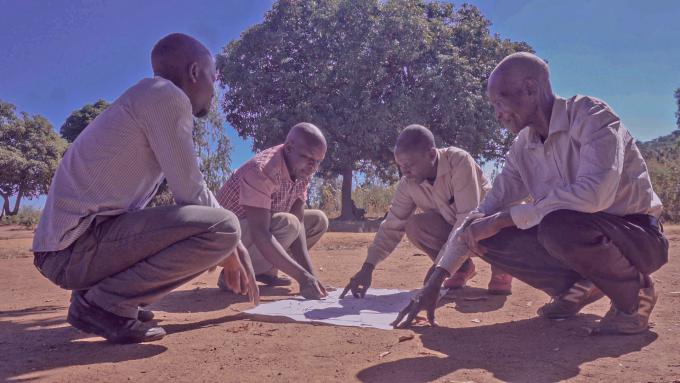Armed with technology, villagers brace for rainy days

In Muhilili Village in the district of Zomba, a forest of trees atop sitting on a hill stands like a crown jewel at the heart of the village—lush and forestry—a sharp contrast to the bare hills in the surrounding villages which pale in comparison.
But it was not always like this.
Group Village Headman Muhilili, the area’s traditional leader, says previously, the area used by be barren and desolate which made the area susceptible to floods and other natural disasters.
He explains that, over the years, the Resilient Economic Development (RED) project has worked with the community in developing environmental and natural resources, especially forestry and fighting malnutrition in the village.
Awali Mbaisa is a committee member of the village natural resource mobilization committee that protects the village’s natural resources, especially the forest.
“We started our project in 2009 and since then we have managed to protect our forest from deforestation. In 2021, the RED project came and gave us extra training on how to manage our natural resources. As a committee, we came up with some by-laws which are followed in the community in order to protect the natural resources. For example, if a person is found cutting down trees without being authorized, they are fined K100,000 ($100),” he says.
The disaster preparedness, resilience and forestry management component of the RED project looks at how economic and nutrition pathways are protected from shocks and stress by developing disaster reduction plans at community and household level and facilitating participatory scenario planning.
Moses Kachitenji is resilience coordinator for the RED Project and is responsible for the component.
According to Kachitenji, the project focuses on three components; cash preparedness where the project has a high component of crisis modifier aimed at supporting the communities in case of disasters. The project also has a natural resource component, which looks at the communities’ best practices for disaster risk mechanisms.
“The communities in Traditional Authority Mbiza face a number of disasters and, as a project, we are working with the government to make sure that we build their capacity on how they can support themselves in times of disasters.
“So, we have basically trained government officials that are responsible for disaster risk management as well as 25 village committees. After this process, we undertook disaster risk assessment where appreciated the hazards the community face and assessed the capacities they have and also the vulnerabilities. We also supported them to develop disaster risk management plans such as early warning, contingency plan and mitigation,” he explains.
Charles Malizani is responsible for mapping in Muhilili Village, a task that requires him and his team to map out disaster prone areas.
“These maps help us to indicate areas that are at risk of natural disasters such as floods and droughts, thereby giving us a chance of coming up with plans such as mitigation, contingency and early warning to prepare and try to prevent the disasters,” he says.
Malizani works hand-in-hand with Fryson Banda who heads the village’s disaster prevention committee whose job is to reduce and prevent natural disasters in the area.
“The RED project gave us a phone through which we receive early disaster warning messages. And under another project, PRO-ACT, Save the Children gave us a rain gauge which we use to measure how the rain is falling. These early warnings, which we learnt through the RED Project, have really helped us to be prepared for any natural disasters, especially floods and heavy wind,” he says.
One other area that has proved effective for the community is the disaster management aspect.
When 58-year-old widow Mary Tchale was on the verge of destitution when her house went down in a heap during the Cyclone Ana-induced torrential rains late last year.
“After the accident, I went to register with the committee responsible for natural disasters in our village and later on, we were called to receive help of around K40,000 ($40) which I used to buy bricks and materials to renovate the house. I used the remaining amount to buy school materials for my three children,” she says.
Mary Wahela is vice secretary of the Muhilili village’s natural disaster committee. She says that, as part of the contingency plan for disasters, the committee last year collected 37 bags of maize from community members plus K48,000 ($48) which was used to purchase chemicals and sacks for storage of the maize.
“During the same year, we had a fire accident where houses of 33 families affected. But we managed to help these families with bag of maize each and plastic sheets for roofing. This year, we have also started collecting and gathering maize from the community to keep for times of disaster,” she says.
 Malawi
Malawi